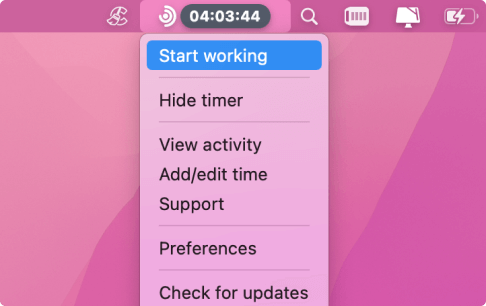
It’s not at all surprising if you’re tired of hearing about all the AI buzz from your coworkers, your boss, and in every odd article you come across in the ocean of information of the contemporary interwebs. You may have used an AI tool or two during your workweek to make a work email sound less scathing and more professional, but that can hardly be called “boosting productivity” with artificial intelligence.
Is there really something productive hiding behind all this AI hype, or is hype all it is? Is it a magic wand that you can wave to get everything done in an hour, or is it just vaporware that runs on hopes and dreams? AI features, such as automated scheduling and task optimization, enhance productivity by streamlining operations and providing personalized recommendations. Let’s come down to earth a bit and take a closer look at some situations where using AI tools can actually do quite a lot of good, especially in the case of time tracking and management.
Introduction to Time Management
Effective time management is crucial for achieving success in both personal and professional life. It involves planning, organizing, and controlling how you spend your time to maximize productivity and efficiency. With the help of AI tools, individuals can streamline their workflows, automate repetitive tasks, and make informed decisions to optimize their time usage. AI-powered tools can assist in managing complex projects by breaking them down into manageable tasks so that nothing falls through the cracks.
They can also help in prioritizing tasks based on urgency and importance, making it easier to focus on what truly matters. Additionally, AI tools can simplify scheduling meetings by finding optimal times that fit everyone’s availability, reducing the back-and-forth often involved in coordinating schedules. By leveraging AI-powered tools, individuals can enhance their time management skills, leading to improved productivity and a better work-life balance.
The Time Management Sink
Try to think about how much time you actually waste during your workday. Do you manage time effectively, or do you take frequent coffee breaks? Do you check your social media notifications once in a while or peruse its infinitely scrolling walls? How about going to a weekly meeting where you discuss the same exact thing that you went over last week? If you had to guess, how much does that time add up in a week, a month, a year?

The real number might be more than you expect. Professionals surveyed by staffing firm OfficeTeam said they squander an average of 56 minutes per day with things like non-work-related browsing and short video binges. Those harmless “just five minutes” social media checks? They can add up to nearly two full hours per week. If you’re in a remote team, distractions tend to scale up even more—and that’s not even counting time spent in meetings that could have been an email.
On-site teams aren’t safe from these inefficiencies, either. Frequent interruptions, unnecessary paperwork, and overlapping red tape consume valuable hours. The result? A slow, creeping productivity drain that most teams don’t even realize is happening. Although the reality of reaching 100% productivity in any line of work is on par with reaching the speed of light, there’s no way to achieve a reasonable golden mean without knowing where your time management actually stands. AI tools can also help in reducing errors by automating repetitive tasks so that everything is done with higher accuracy and efficiency.
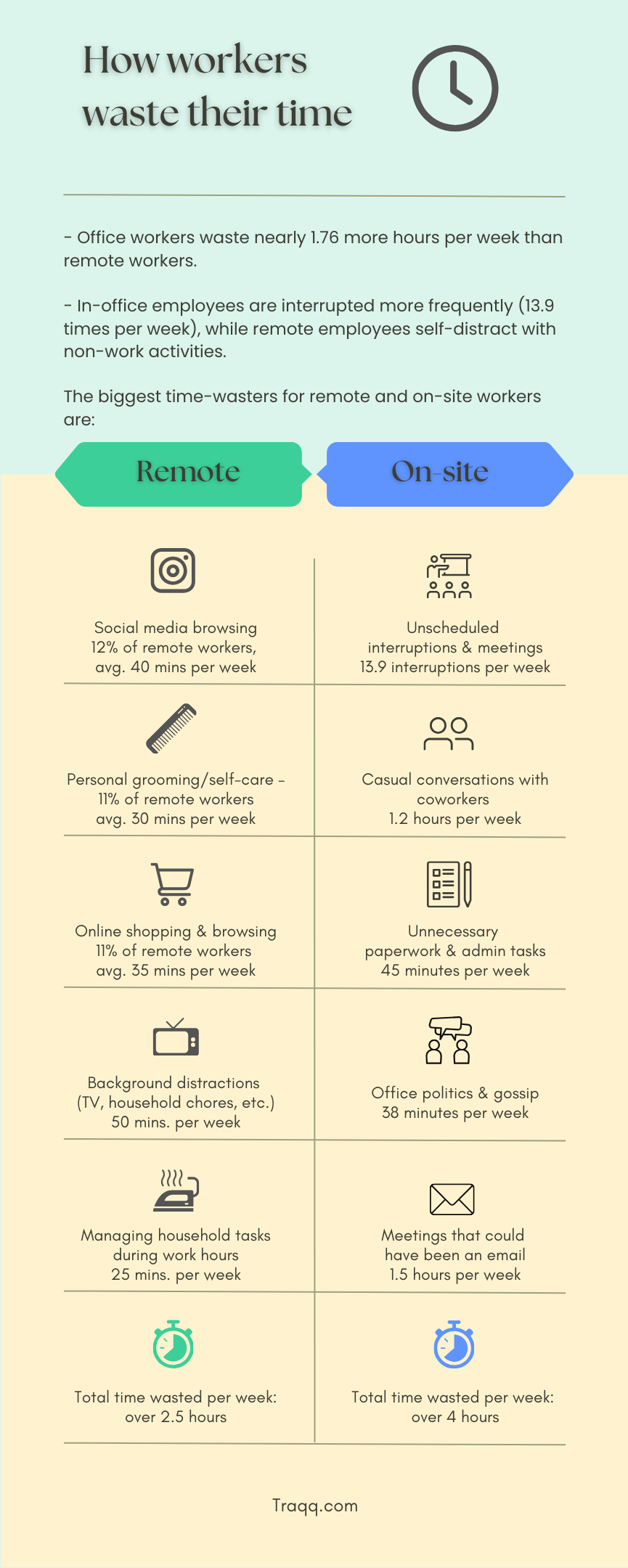
Task Management Productivity Hacks
Recognizing inefficiencies is half the battle, and sometimes, all it takes is a fresh perspective. Take Madeline Mann, the founder of Self Made Millennial, who noticed a frustrating pattern—her workdays were constantly interrupted by meetings, making it nearly impossible to get meaningful, focused work done. “The context-switching of going from call to deep work to call just wasn’t working,” Mann recalled. Instead of accepting this as a necessary evil, she decided to experiment: what if she eliminated meetings on certain days?

She implemented meeting-free Tuesdays and Fridays, reserving the remaining days for all necessary calls. The result? A massive boost in productivity. With dedicated time for deep work, she was able to focus on high-priority tasks without interruptions, improving both efficiency and work quality. One can only venture a guess at how she measured her findings, but Mann stands by the results.
Now, imagine if these kinds of hidden productivity “hacks” existed all around you—small, easily adjustable factors waiting to be uncovered. With the right tools, recognizing and leveraging these patterns can be a game-changer.
AI Tools-Powered Boost
This is where AI tools come in. AI tools can help manage multiple responsibilities by providing intelligent prioritization and automated scheduling, making it easier to handle various tasks effectively. Granted, they won’t do your work for you, but that might be a good thing in the long run. Jokes aside, AI-driven tools aren’t here to replace managers or teams, just like the invention of the telescope didn’t replace our need for eyes. Rather, properly implemented AI-driven software can enhance decision-making in project management by uncovering patterns humans tend to overlook.
For example, Traqq, an AI-driven time tracking and productivity management tool, provides real-time, actionable insights into work habits. With a few intuitive clicks, you can take a close look at your team’s peak productivity hours to establish when and why the activity drops off. With this kind of actionable data, teams can pinpoint the best timeframes to schedule deep-focus work without interruptions.
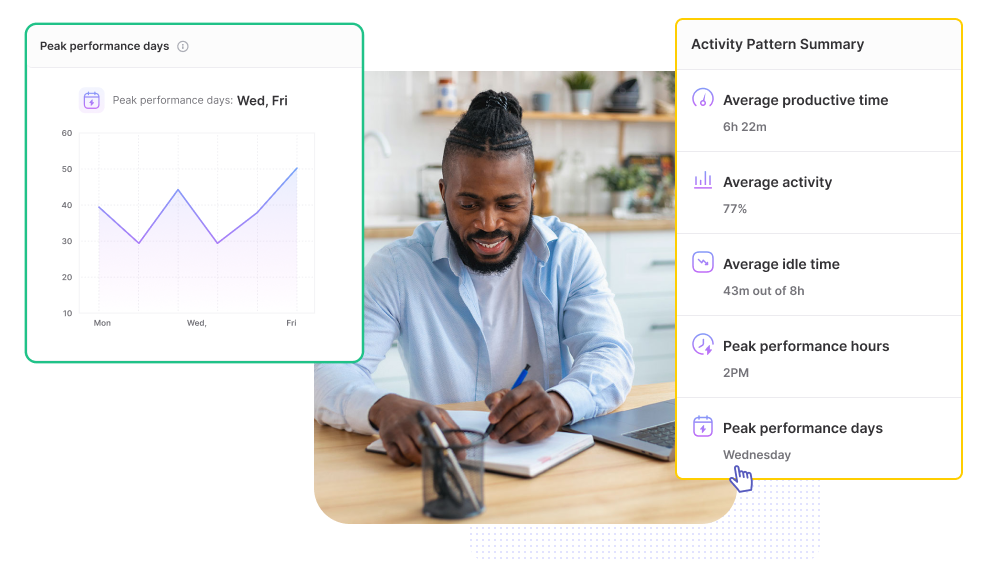
Traqq also provides real-time insights into work habits, allowing managers to monitor project progress and identify issues as they arise. The insights don’t stop there. Identifying when employees are overextending themselves with excessive overtime or weekend work can lead to the creation of strategies that prevent burnout. How about analyzing distraction trends to minimize time-wasting activities? That can significantly improve overall productivity if addressed tactfully.
What about factoring in your distributed team’s geographical spread when establishing prime-time GSD days? That could certainly put the “done” in “GSD”. There are just a few of the countless ways this technology can make a real impact on your business, and all it takes to uncover these hidden gems is to implement these AI tools and start using them.
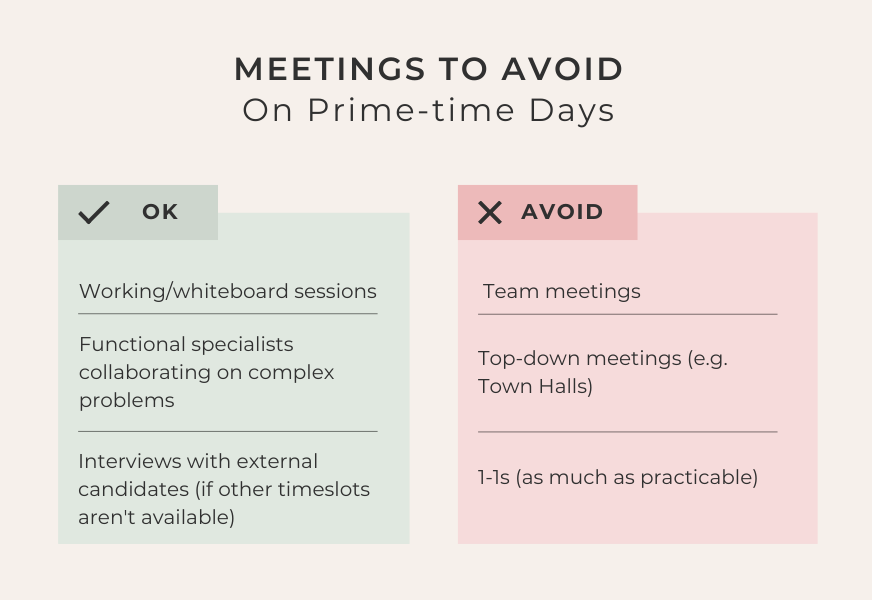
Take it from some of the world’s industry leaders, such as Shopify and Modern Health, who have come across similar situations as Madeline Mann—the ability to track and optimize work patterns is what separates high-performance teams from those constantly struggling to meet deadlines.
While AI tools are often described in surface-level terms around the office and in promotional emails, the usefulness of AI-driven software goes far beyond automating away repetitive tasks. When applied to a robust productivity management tool like Traqq, AI identifies efficiency gaps and provides actionable recommendations, allowing managers to make informed decisions without having to micromanage their staff.
Task Management with AI
Task management is a critical aspect of time management, and AI tools can significantly enhance this process. AI-powered task managers can analyze work patterns, identify inefficiencies, and provide personalized recommendations to help individuals prioritize tasks and manage their time more effectively. These tools can also automate routine tasks, such as scheduling meetings, sending reminders, and assigning tasks to team members.
By leveraging AI-powered task management, individuals can focus on more meaningful tasks, reduce their cognitive load, and boost their productivity. Additionally, you can integrate the insights provided by Traqq’s AI tools with other apps, such as Google Calendar and Microsoft To Do, to provide a holistic approach to task management. This integration will allow you to synchronize all tasks and deadlines across platforms, making it easier to stay organized and on top of your responsibilities. With AI-powered task management, you can transform your to-do list into a dynamic, efficient workflow that adapts to your needs.
Managing Due Dates and Deadlines
Let’s face it—deadlines can feel like ticking time bombs in our daily work lives. That’s where AI steps in as your personal deadline detective. Rather than just reminding you that something’s due (thanks, calendar alerts we all ignore), AI-powered tools track progress patterns, spot potential bottlenecks before they become disasters, and offer smart suggestions to keep projects on track.
These tools don’t just nag you with generic notifications—they adapt to your work habits, sending personalized reminders when you’re most likely to act on them. By letting AI handle the mental load of deadline tracking, you free up valuable brain space for the creative thinking machines still can’t match us on.
The real magic happens when these tools start identifying your productivity patterns. Notice how that weekly report always takes three hours longer than you planned? AI will flag that discrepancy and help you build more realistic timelines. Maybe you consistently underestimate how long client feedback rounds take? The AI has receipts and will suggest padding that timeline next go-around.
With deadline management running more smoothly, you’ll find yourself completing projects without the last-minute panic scrambles that drain energy and compromise quality. The goal isn’t just meeting deadlines—it’s reaching them with your sanity intact and enough creative juice left for whatever comes next.
Thinking Beyond Efficiency
Say you’ve reached near-light speed productivity and your team is operating at peak capacity. Now what? AI isn’t just about squeezing every drop of productivity juice from your workday—there’s also the matter of sustainability. People aren’t robots. No matter how committed we are to our craft, there’s a fine line between dedication and overexertion. AI tools can handle repetitive tasks, reducing the workload and allowing employees to focus on more strategic activities.
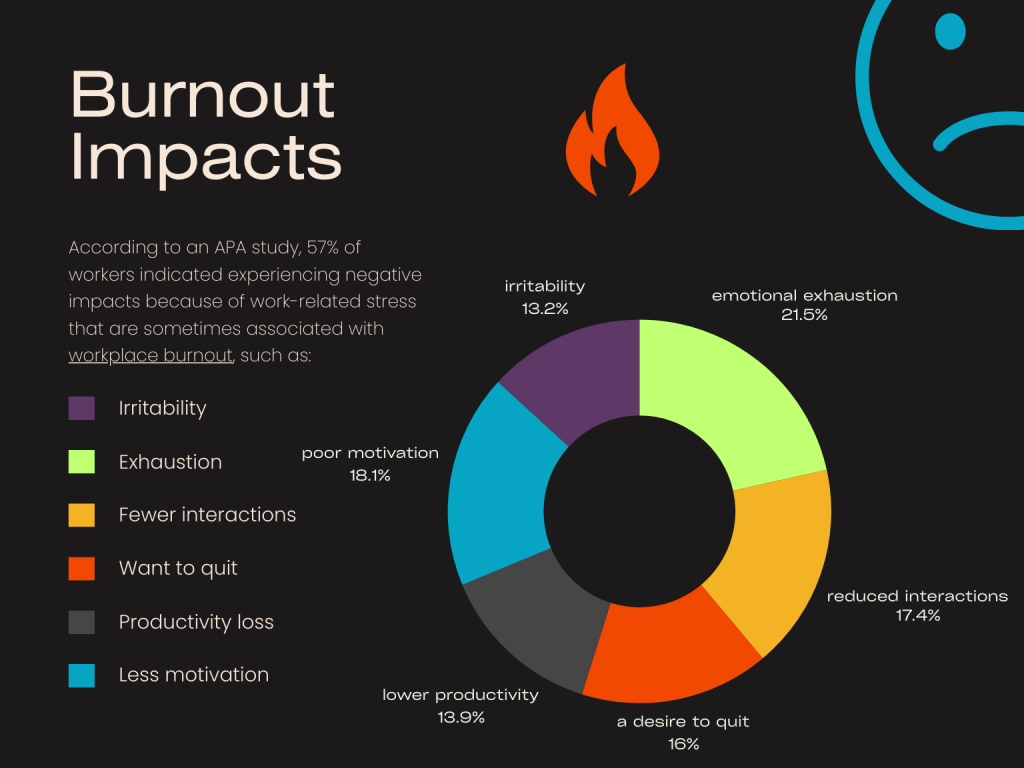
Burnout levels are skyrocketing across the country, with employees citing excessive workload, poor work-life balance, and lack of autonomy as primary causes. According to the American Psychological Association, workplace stress is at an all-time high, with employees struggling due to limited control over their schedules and increased job demands. Meanwhile, a CreateAndGrow study found that 46% of employees identify excessive workload as the leading cause of burnout.
Consider Dr. Claire Ashley, a highly accomplished General Practitioner who began experiencing burnout just six months into her practice. Despite excelling academically and being fully prepared for her role, the relentless workload and complex patient demands quickly took a toll. She started working longer hours, taking fewer breaks, and pushing through exhaustion, believing she just needed to “keep going.” But then the symptoms worsened—headaches, nightmares, and panic attacks.

“As medics we’re taught to leave our problems at the door, so I blamed myself,” Dr. Ashley told the New York Times. Eventually, burnout forced her to resign. With earlier intervention—perhaps recognizing her increasing workload, extended work hours, and stress signals—Dr. Ashley might have received the support she needed to prevent burnout before it reached a crisis point.
Snuffing Out Burnout
The cost of ignoring burnout? Higher turnover rates, disengagement, and compounding hiring costs. That’s where AI-driven tools like Traqq step in once again—not just to keep track of where the workday hours go, but to provide early warning signs of burnout before it leads to resignation. Through Traqq’s Team Health section, managers can identify key warning signs, such as declining activity levels and focus, extended idle periods, frequent late-night work, and a rise in non-work-related app and website usage during work hours. It can even flag disciplinary or attendance issues that may signal deeper engagement problems without infringing on employee privacy through invasive monitoring.

With access to real-time data, managers can step in before burnout becomes irreversible—whether that means adjusting workloads, offering flexible schedules, or providing additional support. AI tools can also help prioritize critical tasks to prevent overwork, ensuring that essential responsibilities take precedence over less urgent ones. The difference between a thriving team and one on the verge of collapse often comes down to early intervention. And companies that take employee well-being seriously don’t just retain talent—they build more engaged, high-performing teams that drive long-term success.
Silent but Effective
Armed with the knowledge of how AI-driven tools like Traqq can fundamentally transform the way you look at and structure your workday, it becomes quite easy to see that AI isn’t just buzzwords and empty promises—it enhances productivity and can be a paradigm shift for productivity when used right. At the heart of every high-performing team is a deep understanding of how time is spent, where inefficiencies hide, and how to strike the balance between working hard and working sustainably.
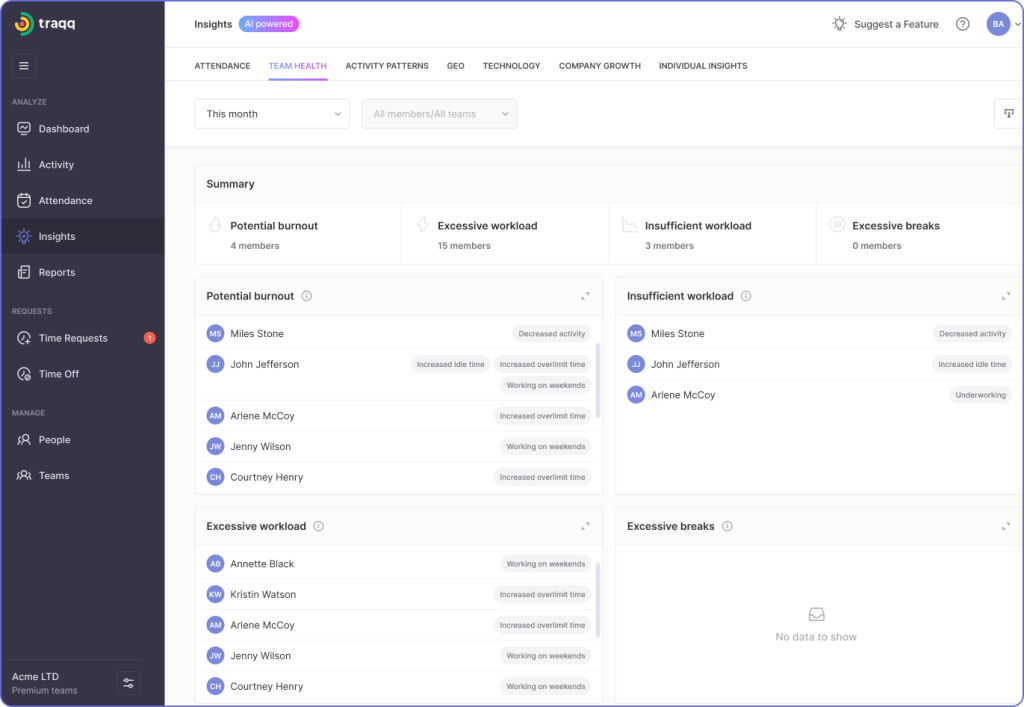
Tools like Traqq’s Insights go beyond simple automation, providing real-time, data-driven visibility into work habits, peak productivity hours, distractions, and burnout risks before they escalate into high turnover. When presented with clear, easily interpretable information, teams can optimize schedules and workloads, cut unnecessary meetings, and prevent overwork. AI tools also provide real-time insights into project progress, allowing for informed decision-making and timely interventions. Instead of chasing trends, Traqq turns AI into a powerful, practical tool that helps you deliver results.
AI isn’t the enemy—it’s the silent assistant working behind the scenes to make sure both managers and employees get the most out of their time. The workplace is evolving, and those who embrace data-driven efficiency will always have the upper hand.

